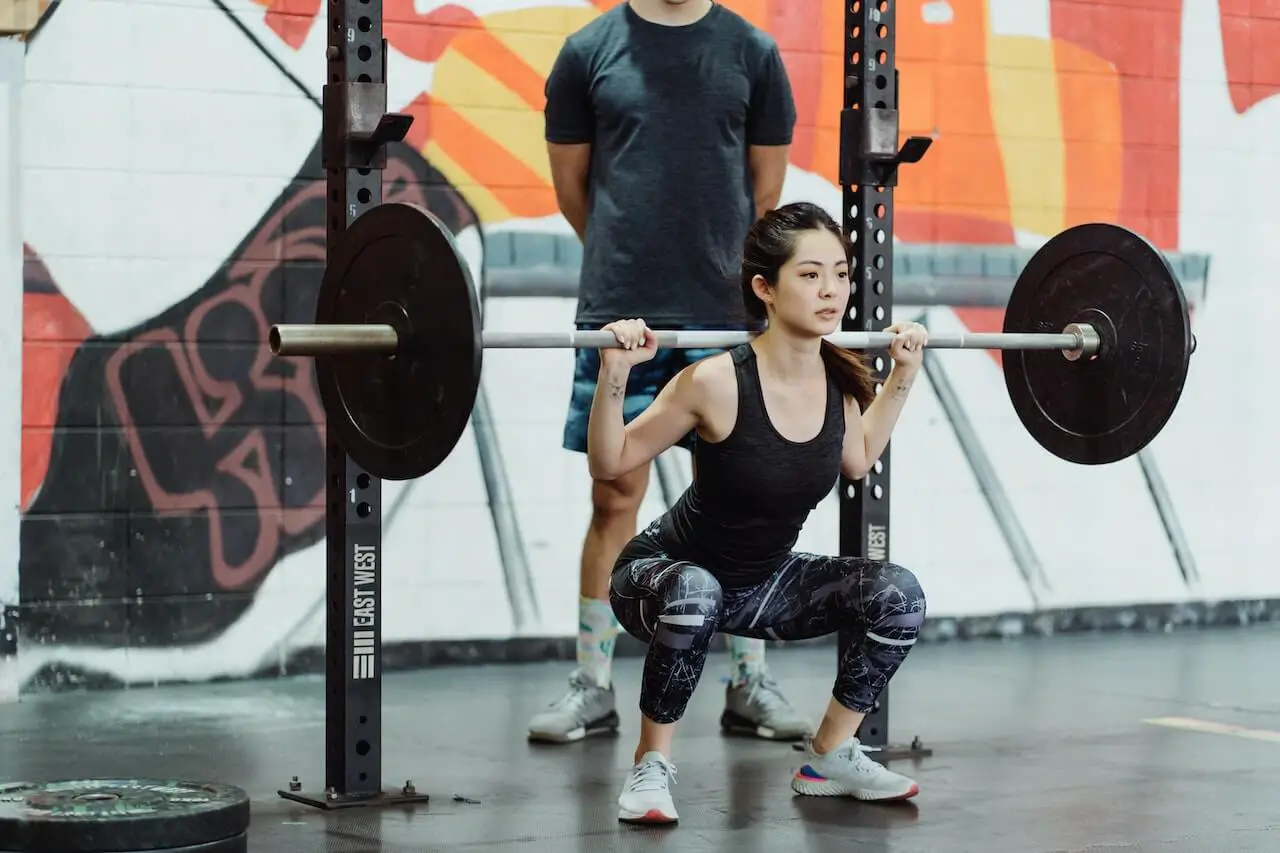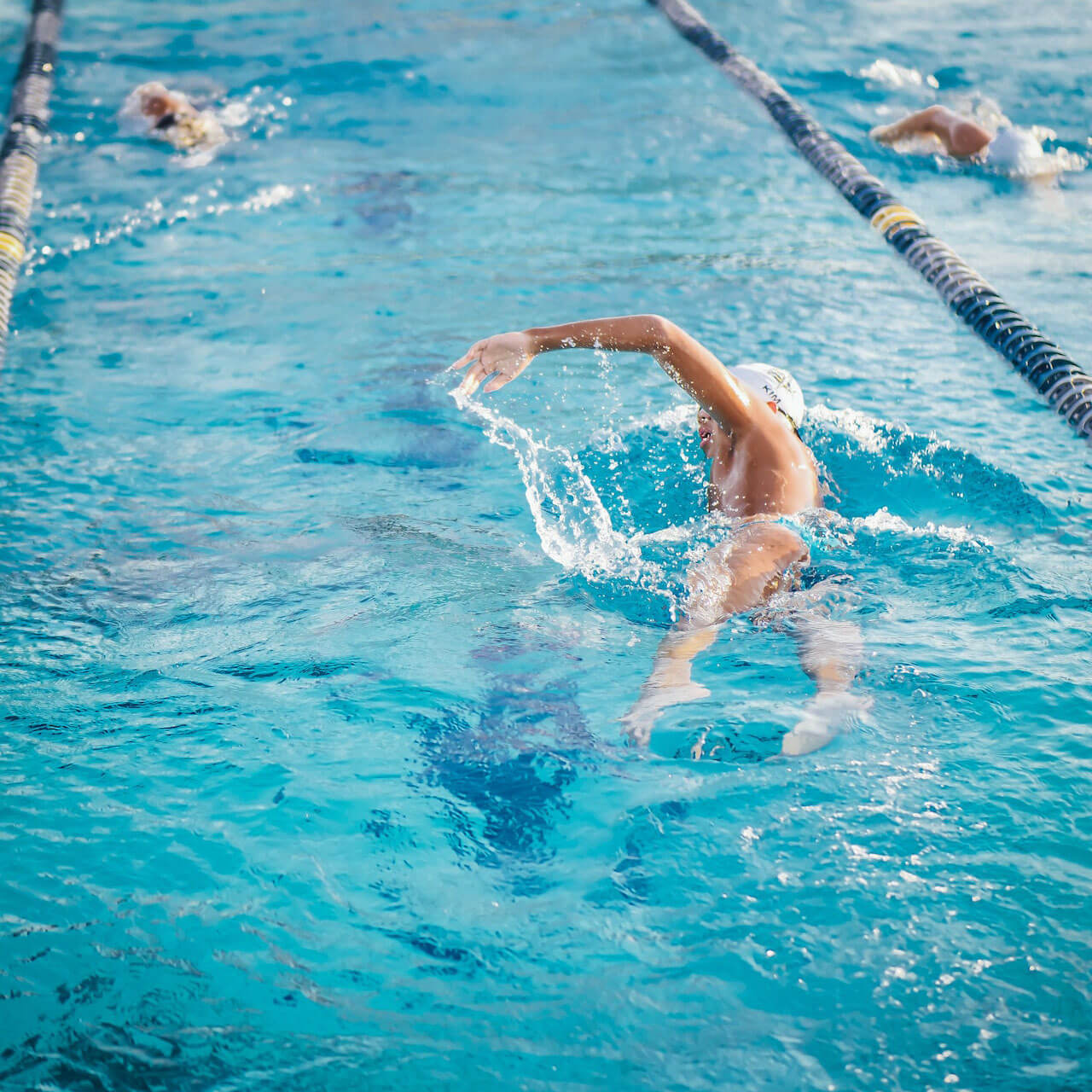Strength training is highly effective at improving your swimming performance, and to that end, squats are an excellent exercise to consider.

Squats are an effective exercise for building strength in the lower body, especially in the knees, hamstrings, quads, and glutes. This strength translates to more powerful starts, turns, underwaters, and overall greater speed and endurance in the pool. Additionally, squats can be performed with various modifications, making them a versatile and accessible exercise for swimmers of all levels.
In this article, we will explore the benefits of squats for swimmers and discuss how they can enhance your swimming abilities.
What You Should Know About Squats
Basics of Squatting
Squats are a fundamental exercise that works various muscle groups in your body. To perform a proper squat, stand with your feet shoulder-width apart and bend your knees while pushing your hips back.
Keep your chest up and your spine neutral. Squats have many variations, including goblet squats and jump squats, which can be tailored to your fitness level and specific training goals.
Muscles Worked During Squats
When you squat, you engage and target several key muscles. Some of the main muscles worked during squats are:
- Quads: The primary movers in the squat are your quadriceps, which are responsible for knee extension.
- Glutes: Your gluteal muscles help you extend and stabilize your hips during the squat.
- Hamstrings: These muscles assist with hip extension and knee flexion during the movement.
- Core: Your abdominal and lower back muscles provide essential stability and support during the squat.
Benefits of Squats Beyond Muscle Building
In addition to building strength in vital muscle groups, squats also provide some other significant benefits for swimmers:
- Increased power: A strong lower body from regular squatting can help improve your starts, turns, and overall swimming speed.
- Mobility: Squats help enhance joint mobility in your hips, knees, and ankles, which is particularly beneficial for swimmers who need a wide range of motion.
- Balance: Squats challenge your stability and balance, improving your body control both in and out of the water.
- Injury prevention: Strengthening the muscles surrounding your joints, particularly in the lower body, can help reduce the risk of injury during swimming.
Remember to maintain proper form and technique to maximize the potential of this powerful exercise.
Benefits of Squats for Swimmers

Improving Start, Turns, and Underwaters
Squats are a fantastic exercise for swimmers as they help improve your starts, turns, and underwaters.
When you squat, your leg muscles, such as your quadriceps, hamstrings, and glutes, are engaged. These muscles are crucial for starts, as they allow you to jump off the block explosively.
The same principle applies to your turns and push-offs from the wall. Strengthening these muscles through squats helps you generate more power and speed during these crucial moments in your swim race.
Building Explosive Power
Another great benefit of squats for swimmers is the development of explosive power. Including exercises like jump squats in your workout routine teaches your body to exert maximum force in a short period.
As a result, your starts, turns, and sprints will be more explosive, giving you an advantage over your competitors.
In addition, the extra power you develop will also benefit your underwater dolphin kicks, allowing you to make the most of each kick and cover more distance underwater.
Increasing Speed and Endurance
Squats are considered a compound exercise, which means that they work multiple muscle groups simultaneously.
By incorporating squats into your strength training routine, you’re not only training your leg muscles, but also engaging your core, hips, and upper back.
This full-body workout translates into greater overall strength, speed, and endurance during your swim sessions.
Moreover, different squat variations like barbell back squats, barbell front squats, or goblet squats offer various muscle activation and range of motion, contributing to better mobility, injury prevention, and stability in the water.
Types of Squats for Swimmers
Bodyweight Squats
Bodyweight squats are an excellent starting point for those new to squats or strength training in general.
Stand with your feet shoulder-width apart, and lower your body by bending your knees and sitting your hips back until your thighs are parallel to the ground. Keep your chest up and core engaged.
Bodyweight squats target your glutes, hamstrings, quads, and core muscles while also helping to improve your balance and overall body awareness.
Goblet Squats
Goblet squats add an extra layer of difficulty to bodyweight squats by incorporating a dumbbell.
Hold a dumbbell vertically at chest level with both hands, and perform the squat as previously described.
Goblet squats not only work your lower body but also engage your lats and core, providing added benefits for your swimming performance.
Front Squats
Front squats involve using a barbell, which makes for a more challenging variation.
Rest the barbell on your front deltoids (shoulder muscles), keeping the bar just in front of your neck, and perform the squat as usual while maintaining an upright torso.
This variation not only targets the lower body but also demands extra work from your core, lats, and lower back in stabilizing the weight.
Back Squats
Back squats change where the barbell rests: on the trapezius muscles on the upper part of your back, behind your neck. You should rest the barbell on your muscle, not on your bone.
This technique places even more emphasis on your glutes and hamstrings while still engaging your quads, which can result in more powerful kicks in the pool.
Keep your back straight and engage your core throughout the movement. Position your feet shoulder-width apart, and keep your knees tracking over your toes as you lower your hips and bend your knees.
Your lats, quads, hamstrings, and glutes should all be working together during the squat.
Jump Squats
Jump squats are an explosive variation that mimic the movements many swimmers use to initiate their kick.
Start as though performing a regular bodyweight squat. As your thighs become parallel to the floor, push through your feet to jump upward, landing softly with knees bent slightly before dropping back into a squat.
This move targets your glutes, quads, and hamstrings, and is an excellent way to practice the quick, explosive power necessary for better push-offs and turns.
Incorporating these types of squats into your strength training routine can help you to develop stronger legs, a powerful core, and improved balance—traits that are essential for any swimmer looking to improve their performance in the pool.
Sources:
- https://columbiaassociation.org/swim/why-squats-are-so-great-for-swimmers/
- https://swimlikeafish.org/why-are-squats-good-for-swimming
- https://swimcompetitive.com/training/strength-exercises-swimmers/
- https://us.humankinetics.com/blogs/excerpt/back-squat-to-improve-swimming
- https://www.yourswimlog.com/best-strength-training-exercises-for-swimmers/

